Metal-Semiconductor-Metal GeSn Photodetectors on Silicon for Short-Wave Infrared Applications
Abstract
1. Introduction
2. Materials and Methods
2.1. Device Design
2.2. Material Growth and Characterization
2.3. MSM PD Fabrication
2.4. Electrical and Optical Measurements
3. Results and Discussion
3.1. Material Characterization
3.2. Dark Current, Photogenerated Current, and Gains
3.3. Spectral Responsivity
3.4. Numerical Analysis
4. Conclusions
Author Contributions
Funding
Acknowledgments
Conflicts of Interest
References
- Vivien, L.; Rouviere, M.; Fedeli, J.-M.; Marris-Morini, D.; Damlencourt, J.-F.; Mangeney, J.; Crozat, P.; Melhaoui, L.E.; Cassan, E.; Roux, X.L.; et al. High Speed and High Responsivity Germanium Photodetector Integrated in a Silicon-On-Insulator Microwaveguide. Opt. Express 2007, 15, 9843–9848. [Google Scholar] [CrossRef]
- Chen, L.; Lipson, M. Ultra-low Capacitance and High Speed Germanium Photodetectors on Silicon. Opt. Express 2009, 17, 7901–7906. [Google Scholar] [CrossRef]
- Rasras, M.S.; Gill, D.M.; Earnshaw, M.P.; Doerr, C.R.; Weiner, J.S.; Bolle, C.A.; Chen, Y. CMOS Silicon Receiver Integrated with Ge Detector and Reconfigurable Optical Filter. IEEE Photon. Tech. Lett. 2009, 22, 112–114. [Google Scholar] [CrossRef]
- Subbaraman, H.; Xu, X.; Hosseini, A.; Zhang, X.; Zhang, Y.; Kwong, D.; Chen, R.T. Recent Advances in Silicon-based Passive and Active Optical Interconnects. Opt. Express 2015, 23, 2487–2511. [Google Scholar] [CrossRef] [PubMed]
- Vivien, L.; Polzer, A.; Marris-Morini, D.; Osmond, J.; Hartmann, J.M.; Crozat, P.; Cassan, E.; Kopp, C.; Zimmermann, H.; Fédéli, J.M. Zero-bias 40Gbit/s Germanium Waveguide Photodetector on Silicon. Opt. Express 2012, 20, 1096–1101. [Google Scholar] [CrossRef] [PubMed]
- Wang, J.; Lee, S. Ge-photodetectors for Si-based Optoelectronic Integration. Sensors 2011, 11, 696–718. [Google Scholar] [CrossRef] [PubMed]
- Soref, R. Silicon-based Silicon-germanium-tin Heterostructure Photonics. Philos. Trans. R. Soc. A. 2014, 372, 20130113. [Google Scholar] [CrossRef] [PubMed]
- Deen, M.J.; Basu, P.K. Silicon Photonics: Fundamentals and Devices; Willey: Hoboken, NJ, USA, 2012. [Google Scholar]
- Michel, J.; Liu, J.; Kimerlin, L.C. High-performance Ge-on-Si Photodetectors. Nat. Photonics 2010, 4, 527–534. [Google Scholar] [CrossRef]
- Bauer, M.; Taraci, J.; Tolle, J.; Chizmeshya, A.V.G.; Zollner, S.; Smith, D.J.; Menendez, J.; Hu, C.; Kuovetakis, J. Ge-Sn Semiconductors for Band-gap and Lattice engineering. Appl. Phys. Lett. 2002, 81, 2992–2994. [Google Scholar] [CrossRef]
- Chizmeshy, A.V.G.; Ritter, C.; Tolle, J.; Cook, C.; Menendez, J.; Kuovetakis, J. Fundamental studies of P(GeH3)3, As(GeH3)3, and Sb(GeH3)3: Practical n-dopants for New Group IV Semiconductors. Chem. Mater. 2006, 18, 6266–6277. [Google Scholar]
- Gupta, J.P.; Bhargava, N.; Kim, S.; Adam, T.; Kolodzey, J. Infrared Electroluminescence from GeSn Heterojunction Diodes Grown by Molecular Beam Epitaxy. Appl. Phys. Lett. 2013, 102, 251117. [Google Scholar] [CrossRef]
- Chen, J.-Z.; Li, H.; Chen, H.H.; Chang, G.-E. Structural and Optical Characteristics of Ge1-xSnx/Ge Superlattices Grown on Ge-buffered Si (001) Wafers. Opt. Mater. Express 2014, 4, 1178–1185. [Google Scholar] [CrossRef]
- Dutt, B.; Lin, H.; Sukhdeo, D.S.; Vulovic, B.M.; Gupta, S.; Nam, D.; Saraswat, K.C.; Harris, J.S., Jr. Theoretical Analysis of GeSn Alloys as a Gain Medium for a Si-Compatible Laser. IEEE J. Sel. Top. Quantum Electron. 2013, 19, 251117. [Google Scholar] [CrossRef]
- Oehme, M.; Kostecki, K.; Arguirov, T.; Mussler, G.; Ye, K.; Golhofer, M.; Schmid, M.; Kaschel, M.; Körner, R.A.; Kittler, M.; et al. GeSn Heterojunction LEDs on Si Substrates. IEEE Photon. Technol. Lett. 2014, 26, 187–189. [Google Scholar] [CrossRef]
- Zhou, Y.; Dou, W.; Du, W.; Pham, T.; Ghetmiri, S.A.; Al-Kabi, S.; Mosleh, A.; Alher, M.; Margetis, J.; Tolle, J.; et al. Systematic study of GeSn heterostructure-based light-emitting diodes towards mid-infrared applications. J. Appl. Phys. 2016, 120, 023102. [Google Scholar] [CrossRef]
- Stange, D.; Driesch, N.V.D.; Rainko, D.; Roesgaard, S.; Povstugar, I.; Hartmann, J.-M.; Stoica, T.; Ikonic, Z.; Mantl, S.; Grützmacher, D.; et al. Short-wave infrared LEDs from GeSn/SiGeSn multiple quantum wells. Optica 2017, 4, 185–188. [Google Scholar] [CrossRef]
- Sun, G.; Soref, R.A.; Cheng, H.H. Design of a Si-based lattice-matched room-temperature GeSn/GeSinSn multi-quantum-well mid-infrared laser diode. Opt. Express 2010, 18, 19957–19965. [Google Scholar] [CrossRef]
- Chang, G.-E.; Chang, S.-W.; Chuang, S.L. Strain-Balanced GezSn1-z-SixGeySn1-x-y Multiple-Quantum-Well Lasers. IEEE J. Quantum Electron. 2010, 46, 1813–1820. [Google Scholar] [CrossRef]
- Al-Kabi, S.; Ghetmiri, S.A.; Margetis, J.; Pham, T.; Zhou, Y.; Dou, W.; Collier, B.; Quinde, R.; Du, W.; Mosleh, A.; et al. An Optimally pumped 2.5 µm GeSn laser on Si operating at 110 K. Appl. Phys. Lett 2016, 109, 171105. [Google Scholar] [CrossRef]
- Mukhopadhyay, B.; Sen, G.; De, S.; Basu, R.; Chakraborty, V.; Basu, P.K. Calculated Characteristics of a Transistor Laser Using Alloys of Gr-IV Elements. Phys. Status Solidi B 2018, 255, 1800117. [Google Scholar] [CrossRef]
- Ghosh, S.; Mukhopadhyay, B.; Sen, G. Performance Enhancement of GeSn Transistor Laser with Symmetric and Asymmetric Multiple Quantum Well in the Base. Semiconductors 2020, 54, 77–84. [Google Scholar] [CrossRef]
- Tseng, H.H.; Li, H.; Mashanov, V.; Yang, Y.J.; Cheng, H.H.; Chang, G.-E.; Soref, R.A.; Sun, G. GeSn-based p-i-n Photodiodes with Strained Active Layer on a Si wafer. Appl. Phys. Lett. 2013, 103, 231907. [Google Scholar] [CrossRef]
- Dong, Y.; Wang, W.; Lei, D.; Gong, X.; Zhou, Q.; Lee, S.Y.; Loke, W.K.; Yoon, S.–F.; Tok, E.S.; Liang, G.; et al. Suppression of Dark Current in Germanium-tin on Silicon Surface Passivation Technique. Opt. Express 2015, 23, 18611–18619. [Google Scholar] [CrossRef] [PubMed]
- Ghosh, S.; Mukhopadhyay, B.; Chang, G.E. Design and Analysis of GeSn-Based Resonant-Cavity-Enhanced Photodetectors for Optical Communication Applications. IEEE Sens. J. 2020, 20, 7801–7809. [Google Scholar] [CrossRef]
- Pareek, P.; Ranjan, R.; Das, M.K. Numerical Analysis of Tin Incorporated Group IV Alloy Based MQWIP. Opt. Quantum Electron. 2018, 50, 179. [Google Scholar] [CrossRef]
- Pareek, P.; Das, M.K.; Kumar, S. Responsivity Calculation of Group IV-based Interband MQWIP. J. Comput. Electronics 2017, 17, 319–328. [Google Scholar] [CrossRef]
- Ghosh, S.; Mukhopadhyay, B.; Sen, G.; Basu, P.K. Performance analysis of GeSn/SiGeSn Quantum Well Infrared Photodetector in Terahertz Wavelength Region. Phys. E 2020, 115, 113692. [Google Scholar] [CrossRef]
- Yasar, F.; Fan, W.; Ma, Z. Flexible Amorphous GeSn MSM Photodetectors. IEEE Photon. J. 2018, 10, 2800109. [Google Scholar] [CrossRef]
- Mahmodi, H.; Hasim, M.R. Effects of Post Deposition Annealing on Crystalline State of GeSn Thin Films Sputtered on Si Substrate and Its Application to MSM Photodetector. Mat. Res. Exp. 2016, 3, 106403. [Google Scholar] [CrossRef]
- Mahmodi, H.; Hasim, M.R.; Soga, T.; Alrokayan, S.; Khan, H.A.; Rusop, M. Synthesis of Ge1-xSnxAlloy Thin Films by Rapid Thermal Annealing of Sputtered Ge/Sn/Ge Layers on Si Substrates. Materials 2018, 11, 2248. [Google Scholar] [CrossRef]
- Peng, Y.-H.; Cheng, H.H.; Mashanov, V.I.; Chang, G.-E. GeSn p-i-n Waveguide Photodetectors on Silicon Substrates. Appl. Phys. Lett. 2014, 105, 231109. [Google Scholar] [CrossRef]
- Chang, G.E.; Basu, R.; Mukhopadhyay, B.; Basu, P.K. Design and Modeling of GeSn-based Heterojucntion Phototransistors for Communication Applications. IEEE J. Sel. Quantum Electron. 2016, 22, 8200409. [Google Scholar] [CrossRef]
- Basu, R.; Chakraborty, V.; Mukhopadhyay, B.; Basu, P.K. Predicted performance of Ge/GeSn hetero-phototransistors on Si substrate at 1.55 µm. Opt. Quantum Electron 2015, 47, 387–399. [Google Scholar] [CrossRef]
- Ghosh, S.; Mukhopadhyay, B.; Sen, G.; Basu, P.K. Study of Si-Ge-Sn based Heterobipolar Phototransistor (HPT) Exploiting Quantum Confined Stark Effect and Franz Keldysh Effect With and Without Resonant Cavity. Phys. E 2019, 106, 62–67. [Google Scholar] [CrossRef]
- Ghosh, S.; Mukhopadhyay, B.; Sen, G.; Basu, P.K. Analysis of Some Important Parameters of Si-Ge-Sn RCE-HPT Exploiting QCSE and FKE. In Proceedings of the URSI-RCRS, Varanasi, India, 12–14 February 2020. [Google Scholar]
- Hung, W.-T.; Barshilia, D.; Basu, R.; Cheng, H.H.; Chang, G.-E. Silicon-based High-responsivity GeSn Short-wave Infrared Heterojunction Phototransistors with a Floating Base. Opt. Lett. 2020, 45, 1088–1091. [Google Scholar] [CrossRef] [PubMed]
- Kumar, H.; Basu, R.; Chang, G.-E. Impact of Temperature and Doping on the Performance of Heterojunction Phototransistors. IEEE Photonics J. 2020, 12, 6801814. [Google Scholar]
- Kumar, H.; Basu, R. Effect of Active Layer Scaling on the Performance of Ge1–xSnx Phototransistors. IEEE Trans Electron. Dev. 2019, 66, 3867–3873. [Google Scholar] [CrossRef]
- Kumar, H.; Basu, R. Design and Analysis of Ge/Ge1-xSnx/Ge Heterojunction Phototransistor for MIR Wavelength Biological Applications. IEEE Sensors J. 2020, 20, 3504–3511. [Google Scholar] [CrossRef]
- Sarto, A.W.; Zeghbroeck, B.J.V. Photocurrents in a Metal-Semiconductor-Metal Photodetector. IEEE J. Quantum Electron. 1997, 33, 2188–2194. [Google Scholar] [CrossRef]
- Chuang, S.L. Physics of Photonic Devices, 2nd ed.; Willey: Hoboken, NJ, USA, 2012. [Google Scholar]
- Asar, T.; SüleymanÖzçelik, Ö. Barrier enhancement of Ge MSM IR Photodetector with Ge layer Optimization. Superlattices Microstruct. 2015, 88, 685–694. [Google Scholar] [CrossRef]
- Dushaq, G.; Ammar, N.; Mahmoud, R. Metal-Germanium-Metal Photodetector Grown on Silicon using Low Temperature RF-PECVD. Opt. Express 2017, 25, 32110–32119. [Google Scholar] [CrossRef]
- Casalino, M.; Iodice, M.; Sirleto, L.; Rendina, I.; Coppola, G. Asymmetric MSM Sub-bandgap All-silicon Photodetector with Low Dark Current. Opt. Express 2013, 21, 28072–28082. [Google Scholar] [CrossRef] [PubMed]
- Casalino, M.; Iodice, M.; Sirleto, L.; Rao, R.; Rendina, I.; Coppola, G. Low Dark Current Silicon-on-insulator Waveguide Metal-semiconductor-metal-photodetector Based on Internal Photoemissions at 1550 nm. J. Appl. Phys. 2013, 114, 153103. [Google Scholar] [CrossRef]
- Zhu, S.; Lo, G.Q.; Kwong, D.L. Low-cost and High-Speed SOI Waveguide-Based Silicide Schottky-Barrier MSM Photodetectors for Broadband Optical Communications. IEEE Photon. Tech. Lett. 2008, 20, 1396–1398. [Google Scholar] [CrossRef]
- Chang, G.-E.; Cheng, H.H. Optical Gain of Germanium Infrared Lasers on Different Crystal Orientations. J. Phys. D Appl. Phys. 2013, 46, 065103. [Google Scholar] [CrossRef]
- Ghosh, S.; Lin, K.-C.; Tsai, C.-H.; Lee, K.H.; Chen, Q.; Son, B.; Mukhopadhyay, B.; Tan, C.S.; Chang, G.-E. Resonant-cavity-enhanced Responsivity in Germanium-on-insulator Photodetectors. Opt. Express 2020, 28, 23739–23747. [Google Scholar] [CrossRef] [PubMed]
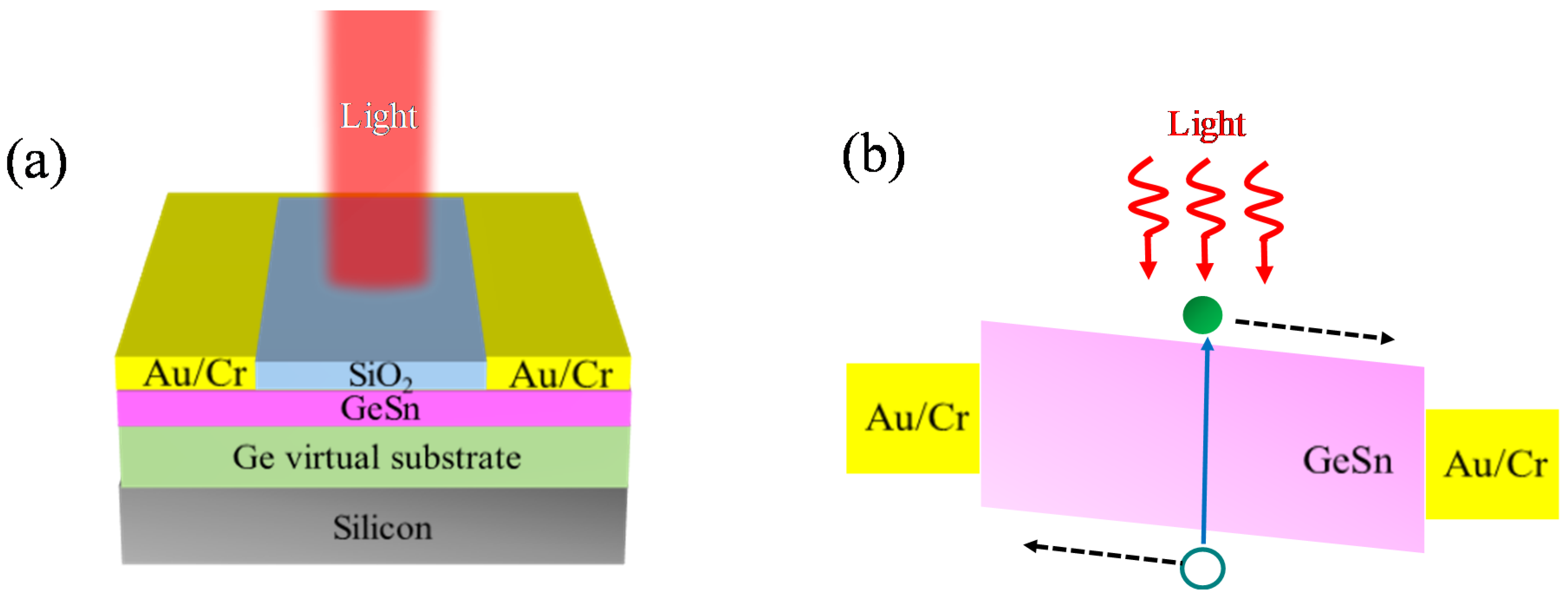
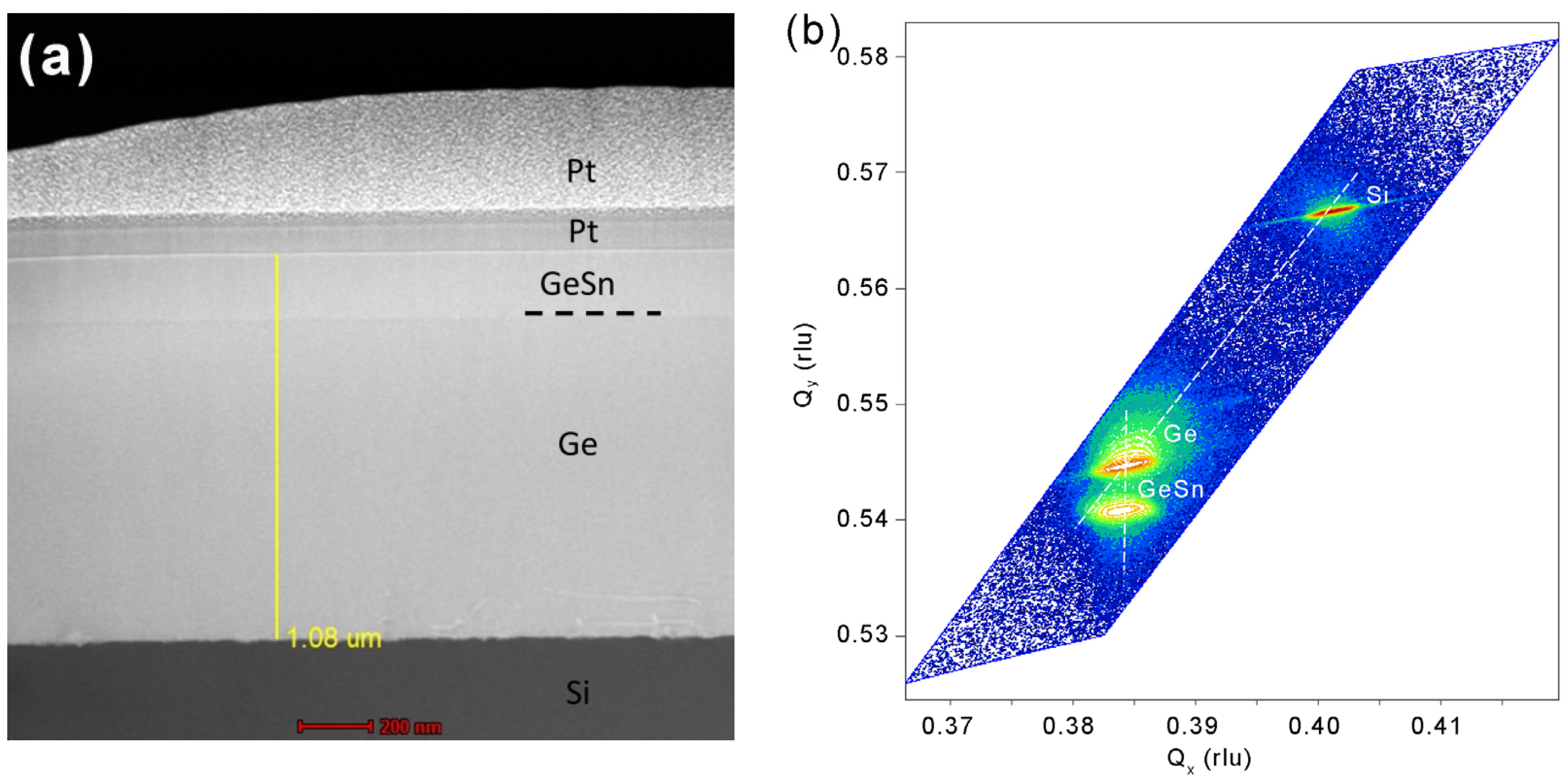
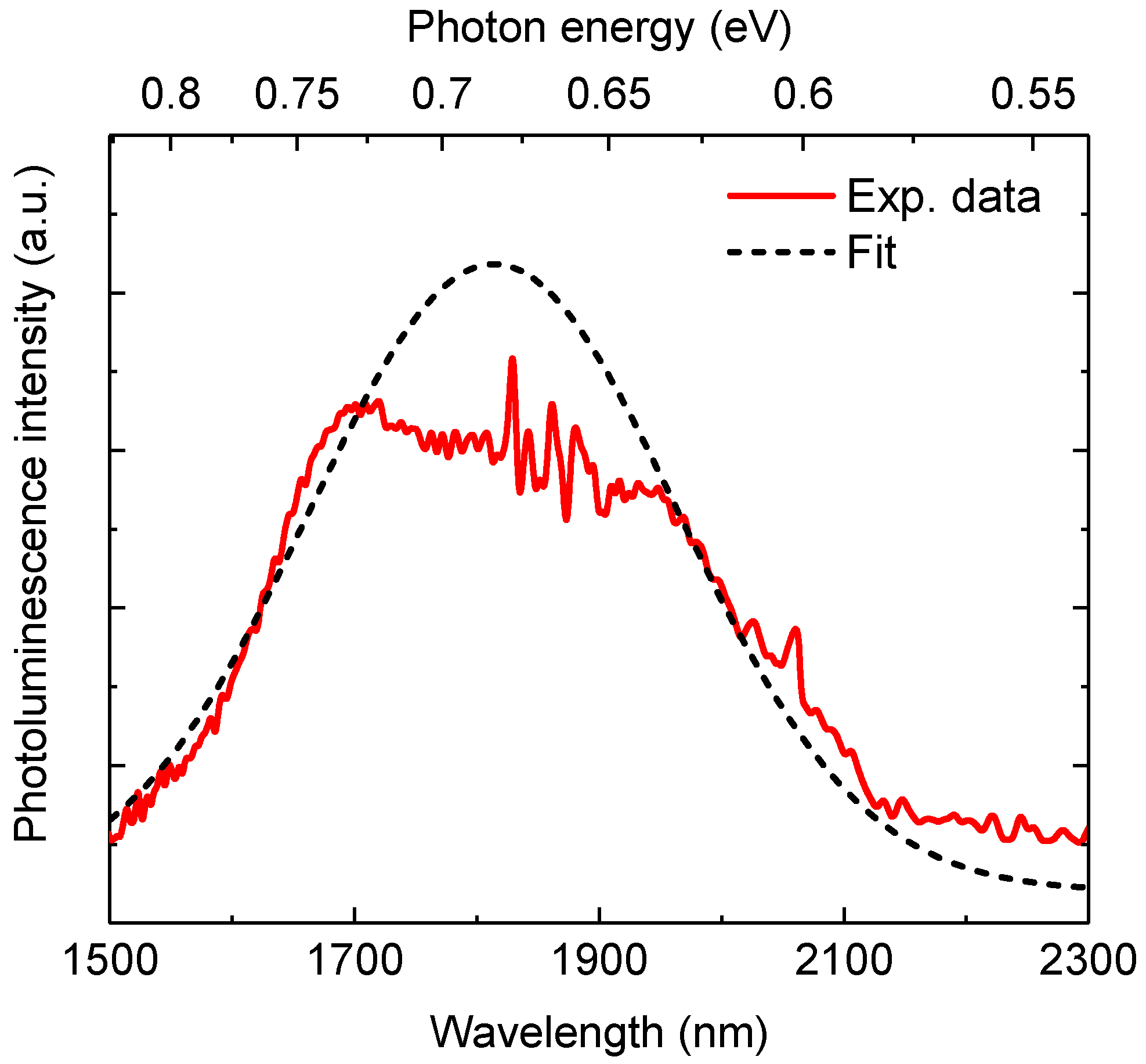
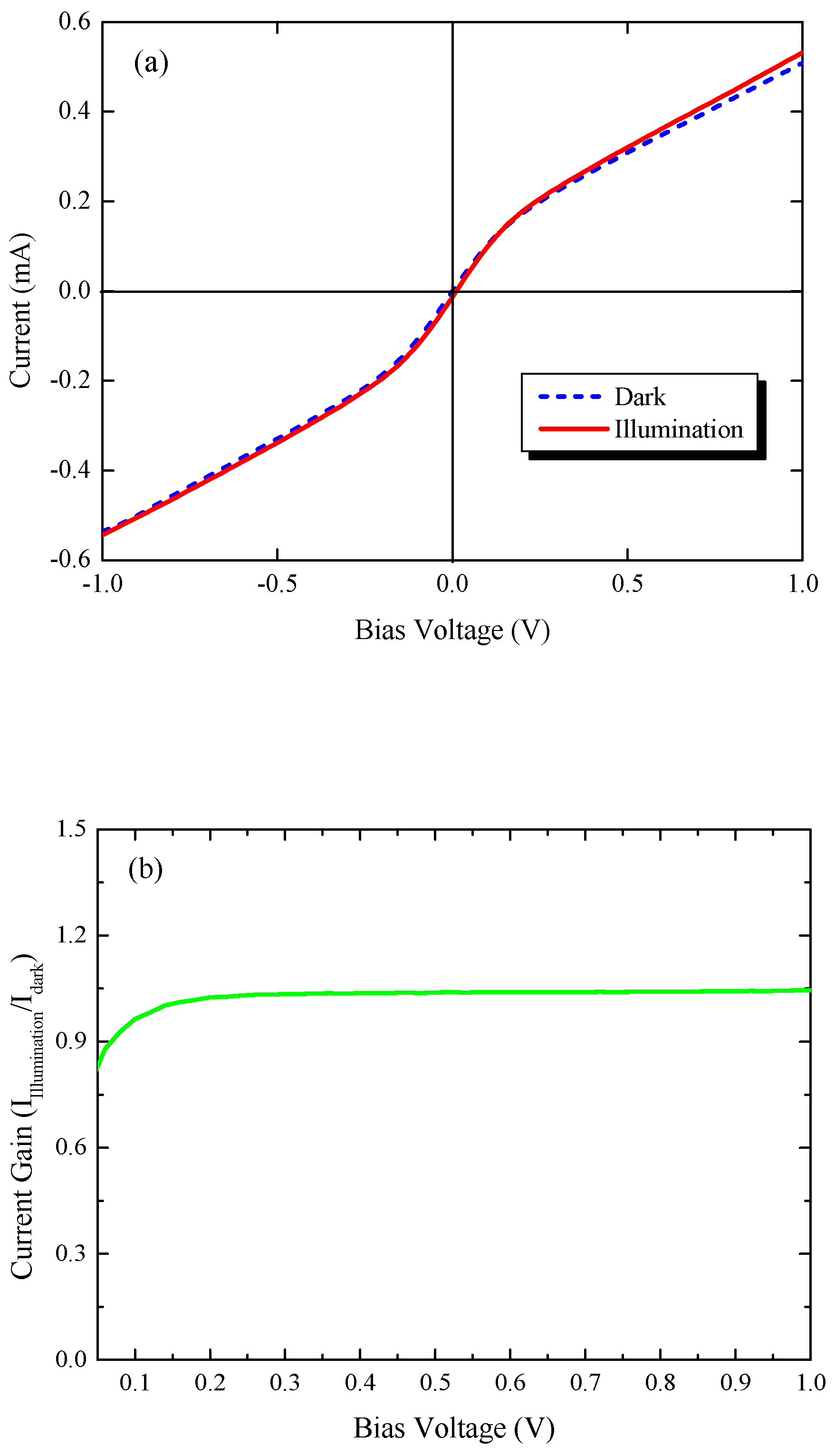
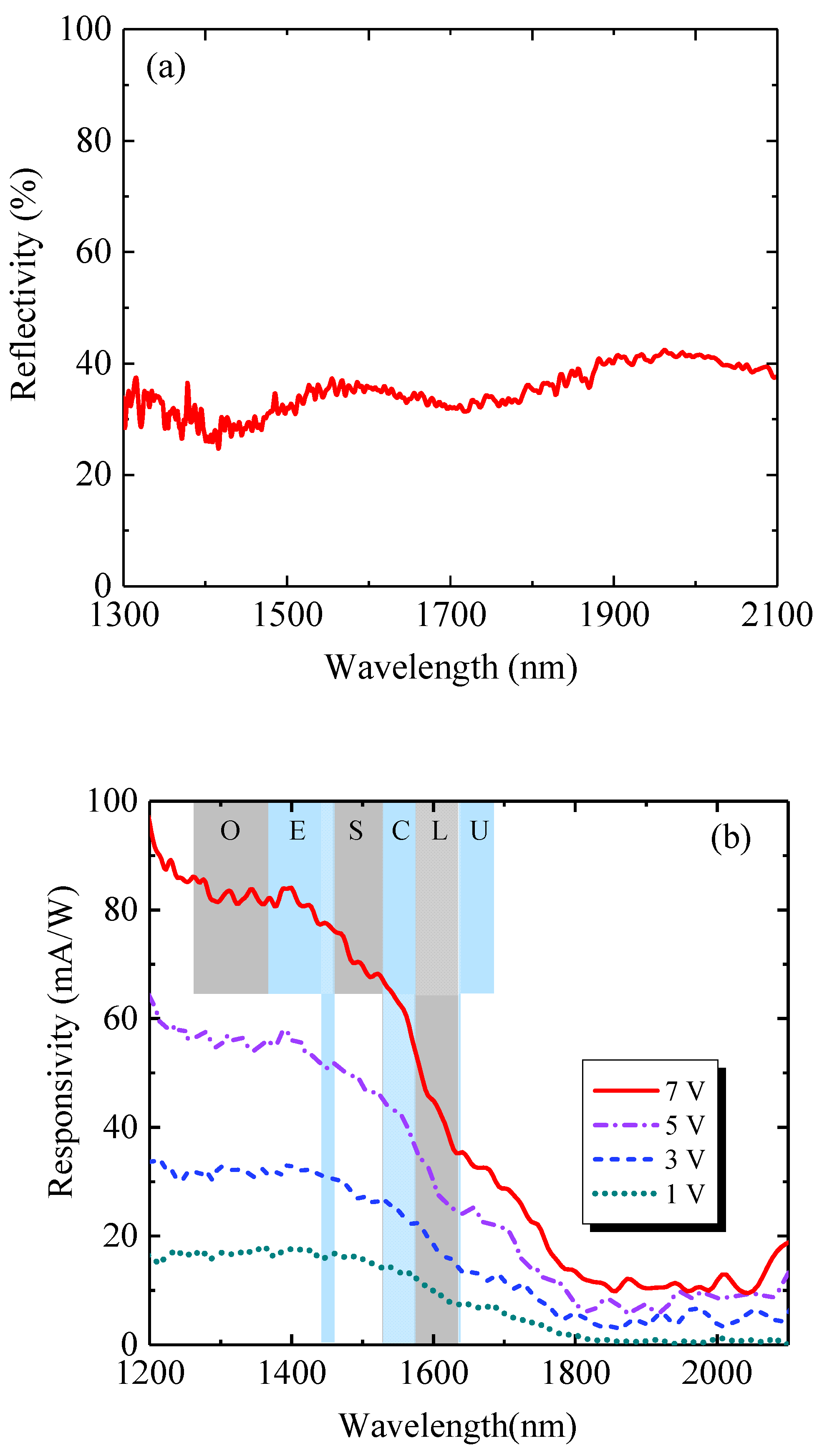
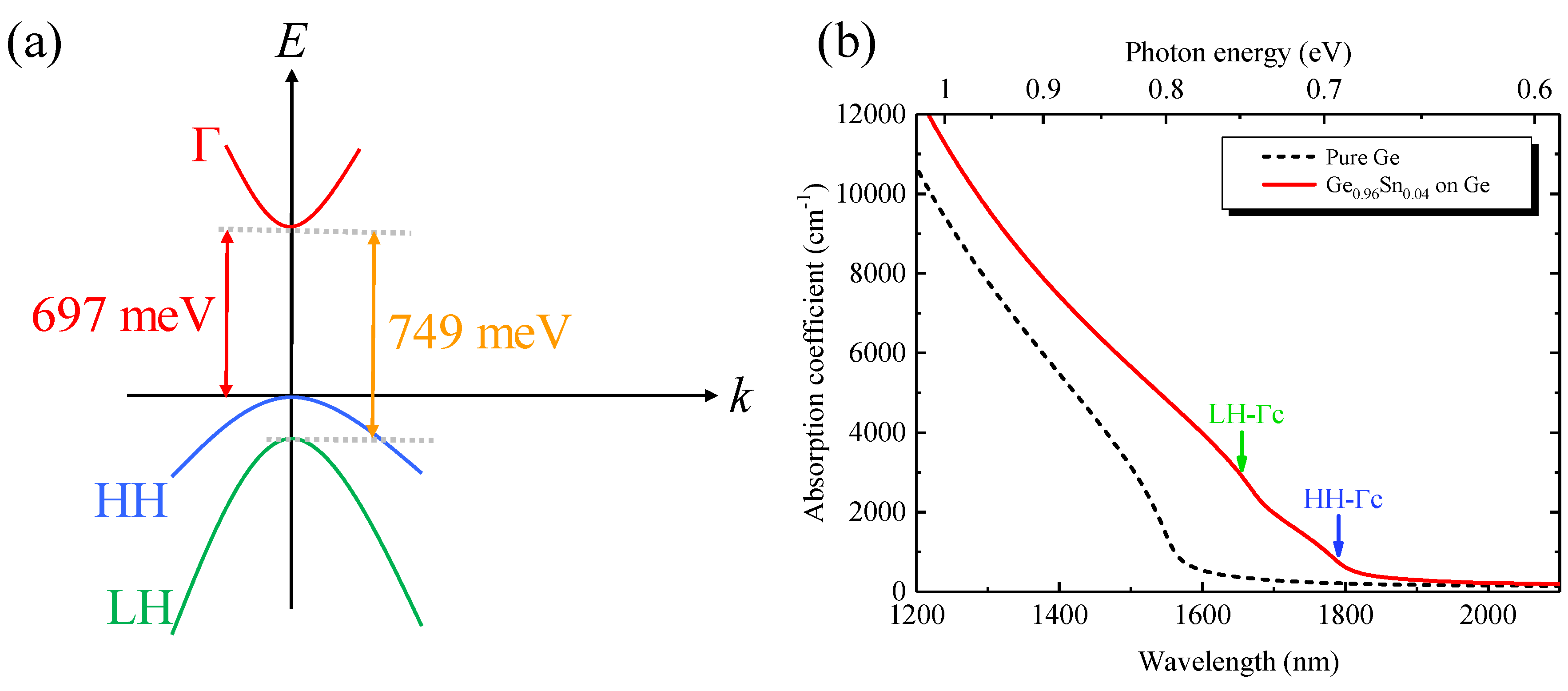
| Layer | Material | Thickness (nm) |
|---|---|---|
| Substrate | Si | 150 |
| Virtual Substrate | Ge | 900 |
| Active Layer | Ge0.96Sn0.04 | 180 |
| Top Passivation Layer | SiO2 | 180 |
| Parameters | Ge | Sn |
|---|---|---|
| Lattice Constant a (Å) | 5.6573 [19] | 6.4892 [19] |
| Electron Effective Masses | ||
| Electron mΓ/m0 | 0.038 [19] | 0.058 [19] |
| Heavy Hole mHH/m0 | 0.28 [34] | |
| Light Hole mLH/m0 | 0.044 [34] | |
| Band gap EgΓ (eV) | 0.7985 [19] | −0.413 [19] |
| Spin-orbit splitting Energy Δ0 (eV) | 0.29 [19] | 0.80 [19] |
| Average Valance Band Energy EVaV (eV) | 0 [19] | 0.69 [19] |
| Luttinger’s parameters | ||
| γ1 | 13.38 [19] | −14.97 [19] |
| γ2 | 4.24 [19] | −10.61 [19] |
| γ3 | 5.69 [19] | −8.52 [19] |
| Deformation Potential | ||
| ac (eV) | −8.24 [19] | −6.00 [19] |
| av (eV) | 1.24 [19] | 1.58 [19] |
| bv (eV) | −2.90 [19] | −2.70 [19] |
| Elastic Constants | ||
| C11 (GPa) | 128.53 [19] | 69.00 [19] |
| C12 (GPa) | 48.26 [19] | 29.30 [19] |
| C44 (GPa) | 68.30 [19] | 36.20 [19] |
| Electron mobility µn (cm2/V-sec) | 3900 [28] | 2940 [28] |
| Hole mobility µp (cm2/V-sec) | 1900 [28] | 2990 [28] |
| Optical Energy Ep (eV) | 26.3 [19] | 24.0 [19] |
| Refractive Index nr | 4.051 [28] | 5.791 [28] |
| Dielectric Constant εr | 16.2 [28] | 24.0 [28] |
© 2020 by the authors. Licensee MDPI, Basel, Switzerland. This article is an open access article distributed under the terms and conditions of the Creative Commons Attribution (CC BY) license (http://creativecommons.org/licenses/by/4.0/).
Share and Cite
Ghosh, S.; Lin, K.-C.; Tsai, C.-H.; Kumar, H.; Chen, Q.; Zhang, L.; Son, B.; Tan, C.S.; Kim, M.; Mukhopadhyay, B.; et al. Metal-Semiconductor-Metal GeSn Photodetectors on Silicon for Short-Wave Infrared Applications. Micromachines 2020, 11, 795. https://doi.org/10.3390/mi11090795
Ghosh S, Lin K-C, Tsai C-H, Kumar H, Chen Q, Zhang L, Son B, Tan CS, Kim M, Mukhopadhyay B, et al. Metal-Semiconductor-Metal GeSn Photodetectors on Silicon for Short-Wave Infrared Applications. Micromachines. 2020; 11(9):795. https://doi.org/10.3390/mi11090795
Chicago/Turabian StyleGhosh, Soumava, Kuan-Chih Lin, Cheng-Hsun Tsai, Harshvardhan Kumar, Qimiao Chen, Lin Zhang, Bongkwon Son, Chuan Seng Tan, Munho Kim, Bratati Mukhopadhyay, and et al. 2020. "Metal-Semiconductor-Metal GeSn Photodetectors on Silicon for Short-Wave Infrared Applications" Micromachines 11, no. 9: 795. https://doi.org/10.3390/mi11090795
APA StyleGhosh, S., Lin, K.-C., Tsai, C.-H., Kumar, H., Chen, Q., Zhang, L., Son, B., Tan, C. S., Kim, M., Mukhopadhyay, B., & Chang, G.-E. (2020). Metal-Semiconductor-Metal GeSn Photodetectors on Silicon for Short-Wave Infrared Applications. Micromachines, 11(9), 795. https://doi.org/10.3390/mi11090795







